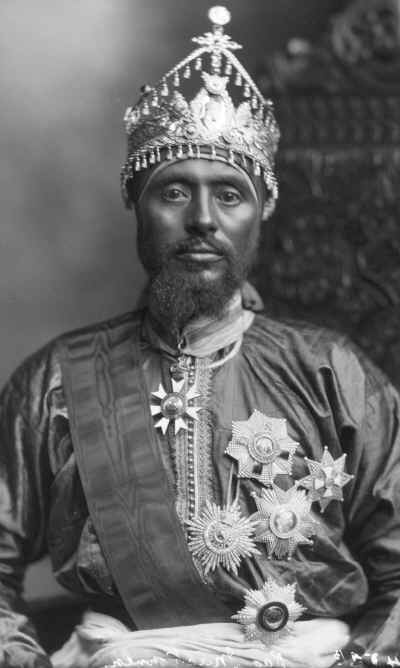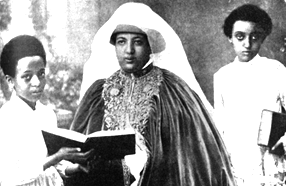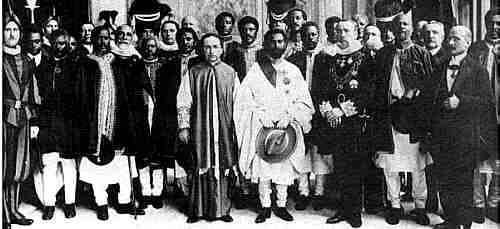His Imperial Highness Crown Prince Ras Tafari Makonnen, Regentof the Ethiopian Empire preparing to meet Pope Pius XI in audience,accompanied by the Vatican secretary of State, Ethiopian Princes andnobility, and with clergy and nobility of the Vatican state, 1923.
 Uponhis return, the Crown Prince was able to please the Empress with thenews that the British government would be returning one of the crownsof Emperor Tewodros II that the Napier expedition had siezed andcarried off from Magdala in 1867. He did have to face however thedeepening hostility to his modernizing zeal on the part of theconservative camp led by Fitarwrari Hapte Giorgis (who had notaccompanied him abroad) and the Archbishop Abune Mattiwos who wasdispleased with the delegations call on the Pope in Rome. Theyrigorously opposed his every move towards modernizing theadministration of the Empire, raising objections, saying that thethings the Prince wanted to do were "un-Ethiopian". Particularly, whentold that slaves were to be freed, Fitawrari Hapte Giorgis is said tohave sputtered with outrage "...so is my wife to carry water on herback from the springs herself????" With the deaths of these twopowerful but elderly men, Ras Taffari was able to consolidate his powerby co-opting much of the Fitawrarris personal forces and staff into hisown, and by postponing the appointment of a new Archbishop by enteringintonegotiations with the Coptic Patriarchate of Alexandria over theposibility of having an Ethiopian appointed to the post for the firsttime.The reluctance of the Patriarch to agree to this resulted in theEthiopian born Echege (Abbot of Debre Libanos Monastery) being thehighestranking cleric in Ethiopia, and he being much more in sympathy with theregent than the Archbishop had been, it was in the interests of thePrinceto let things remain as they were and let the negotiations with theHoly See of St. Mark drag on. The power of the conservatives was thusgreatly reduced. The Empress, although a staunch traditionalist wasincreasingly devoting her time and energies towards prayer and churchbuilding. She was therefore never an effective leader for the forces ofconservatism. Part of the reason for this behavior may have been a deepsense of guilt that she bore for having defied her father's will andreplaced his designated heir on the throne, and also because of herdeep sorrow at being forcefully separated from her husband. Theseevents may have put her in a position of helplessness, and at the mercyof her nobles. After a series of plots and counter plots, an attemptwas made to arrest the Prince-Regent at the Imperial Palace byconservative elements in the cabinet, possibly with the Empressesknowledge and agreement. However, the Crown Prince's wife got wind ofthe plot, and was able to alert him as well as send a force of hisguards to the palace to liberate him. The Empress claimed ignorance ofthe plot, although it had been carried out in her name. Progressivesand modernizers in the nobility and the army held an unprecedenteddemonstation in support of Ras Taffari on the grounds of the palace. Inorder to appease the angry progressives who rallied to the CrownPrince, the Empress agreed to crown him king. In November of 1928,Empress Zewditu of Ethiopia crowned Taffari Makonnen asKing and Heir to the Throne of Ethiopia. It was an unusual arangment asthe King would remain in the capital with the Empress, and that noterritorysuch as Wollo or Gondar was given him with the title. It was assumedthat he was king of all Ethiopia, an unprecedented situation. Hiscoronation as Nigus was regarded as a dress rehersal of sorts for hiseventual coronation as Niguse Negest. He would later seeto it that no one else would ever be crowned king once he becameEmperor.
Uponhis return, the Crown Prince was able to please the Empress with thenews that the British government would be returning one of the crownsof Emperor Tewodros II that the Napier expedition had siezed andcarried off from Magdala in 1867. He did have to face however thedeepening hostility to his modernizing zeal on the part of theconservative camp led by Fitarwrari Hapte Giorgis (who had notaccompanied him abroad) and the Archbishop Abune Mattiwos who wasdispleased with the delegations call on the Pope in Rome. Theyrigorously opposed his every move towards modernizing theadministration of the Empire, raising objections, saying that thethings the Prince wanted to do were "un-Ethiopian". Particularly, whentold that slaves were to be freed, Fitawrari Hapte Giorgis is said tohave sputtered with outrage "...so is my wife to carry water on herback from the springs herself????" With the deaths of these twopowerful but elderly men, Ras Taffari was able to consolidate his powerby co-opting much of the Fitawrarris personal forces and staff into hisown, and by postponing the appointment of a new Archbishop by enteringintonegotiations with the Coptic Patriarchate of Alexandria over theposibility of having an Ethiopian appointed to the post for the firsttime.The reluctance of the Patriarch to agree to this resulted in theEthiopian born Echege (Abbot of Debre Libanos Monastery) being thehighestranking cleric in Ethiopia, and he being much more in sympathy with theregent than the Archbishop had been, it was in the interests of thePrinceto let things remain as they were and let the negotiations with theHoly See of St. Mark drag on. The power of the conservatives was thusgreatly reduced. The Empress, although a staunch traditionalist wasincreasingly devoting her time and energies towards prayer and churchbuilding. She was therefore never an effective leader for the forces ofconservatism. Part of the reason for this behavior may have been a deepsense of guilt that she bore for having defied her father's will andreplaced his designated heir on the throne, and also because of herdeep sorrow at being forcefully separated from her husband. Theseevents may have put her in a position of helplessness, and at the mercyof her nobles. After a series of plots and counter plots, an attemptwas made to arrest the Prince-Regent at the Imperial Palace byconservative elements in the cabinet, possibly with the Empressesknowledge and agreement. However, the Crown Prince's wife got wind ofthe plot, and was able to alert him as well as send a force of hisguards to the palace to liberate him. The Empress claimed ignorance ofthe plot, although it had been carried out in her name. Progressivesand modernizers in the nobility and the army held an unprecedenteddemonstation in support of Ras Taffari on the grounds of the palace. Inorder to appease the angry progressives who rallied to the CrownPrince, the Empress agreed to crown him king. In November of 1928,Empress Zewditu of Ethiopia crowned Taffari Makonnen asKing and Heir to the Throne of Ethiopia. It was an unusual arangment asthe King would remain in the capital with the Empress, and that noterritorysuch as Wollo or Gondar was given him with the title. It was assumedthat he was king of all Ethiopia, an unprecedented situation. Hiscoronation as Nigus was regarded as a dress rehersal of sorts for hiseventual coronation as Niguse Negest. He would later seeto it that no one else would ever be crowned king once he becameEmperor.
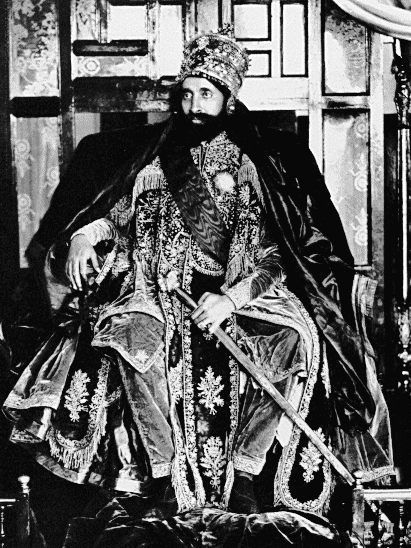 Taffari Makonnen, as King and Heir to the Throne, 1928
Taffari Makonnen, as King and Heir to the Throne, 1928
 Withthe eventuallity of his becoming emperor all the more likely now, thenew kingbegan to accelerate the process of getting an Archbishop fromAlexandria. Although the Copts had been staunch in refusing to name anEthiopian to the post, the Ethiopians were able to get the Patriarch toappoint 4 Ethiopian born suffrugan bishops to serve under the EgyptianArchbishop. The new Egyptian born Archbishop Kyrilos, and the Ethiopianborn Bishops Petros, Abraham, Markos and Lukas were all consicrated inAlexandria and arrived in Ethiopia soon afterwards. The EthiopianChurch was jubilant to haveso many bishops at once, as well as 4 native born bishops. A yearlater, upon the occasion of the visit of the Coptic Patriarch ofAlexandria to Ethiopia, he consicrated the Echege of Debre Libanos, asthe fifth Ethiopian born Bishop with the name Sauiros.
Withthe eventuallity of his becoming emperor all the more likely now, thenew kingbegan to accelerate the process of getting an Archbishop fromAlexandria. Although the Copts had been staunch in refusing to name anEthiopian to the post, the Ethiopians were able to get the Patriarch toappoint 4 Ethiopian born suffrugan bishops to serve under the EgyptianArchbishop. The new Egyptian born Archbishop Kyrilos, and the Ethiopianborn Bishops Petros, Abraham, Markos and Lukas were all consicrated inAlexandria and arrived in Ethiopia soon afterwards. The EthiopianChurch was jubilant to haveso many bishops at once, as well as 4 native born bishops. A yearlater, upon the occasion of the visit of the Coptic Patriarch ofAlexandria to Ethiopia, he consicrated the Echege of Debre Libanos, asthe fifth Ethiopian born Bishop with the name Sauiros.
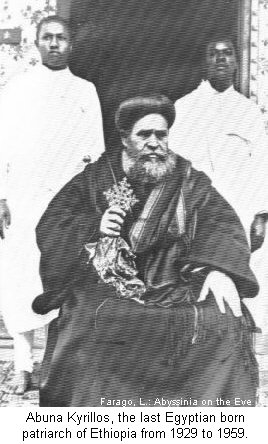 Abune Kyrilos, last Egyptian born Archbishop of the EthiopianOrthodox Church (the caption erroneously refers to him as Patriarch)
Abune Kyrilos, last Egyptian born Archbishop of the EthiopianOrthodox Church (the caption erroneously refers to him as Patriarch)
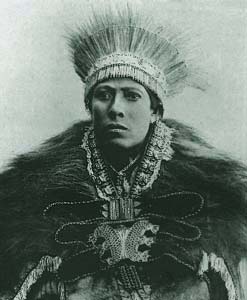 Dejazmatch Balcha Saffo, known as "Balcha Abba Nefso"
Dejazmatch Balcha Saffo, known as "Balcha Abba Nefso"
 Soon after becoming king in 1928, Nigus Taffari recieved yet anotherchallenge from the forces of conservatism. Dejazmatch Balcha Saffo, anOromo unich who had been raised by Emperor Menelik and placed in thepowerful post of Governor of the wealthy province of Sidamo, arrived inAddis Ababa with a very large number of well armed men. He hadrepeatedly refused the summons of the new King to come to the Capital,and only obeyed now because he had recieced a summons from the Empress.Dejazmatch Balcha and his army encamped at Nifas Silk, just outsidethe city, and the presence of Balcha's Army was regarded as being adirect challenge to the king, in support of the Empress and theconservatives she supported. On the secondevening after his arrival, Dejazmatch Balcha and his leading officerswere invited by King Taffari to come to the Imperial Palace for dinner.They arrived to finda fine feast prepared for them, and much to drink. As the evening woreon, and the officers grew more and more intoxicated, they also grewmore and more insultingto the king and his supporters as they sang songs as was customary.When the nobleman and his followers finally returned to Nifas Silk,they were stunned to find thatthe entire army had vanished. While they had been eating and drinkingat the palace, Ras Kassa Hailu and several other officials had arrivedat Nifas Silk with a bag of Silver Maria Theresa Thallers, and anotherbag of whips. They announced to Balcha's army that a new governor, RasBirru, had been appointed for Sidamo and that they were to report tohim. They were to immediately accept payment in the silver coins,surrender their weapons and go home. The bag of whips was left in clearview to show what would happen to anyone who did not obey. Within ashort time, the soldiers had surrendered their weapons, recieved theirpayment and were headed back to their farms and families in thesouth. When Dejazmatch Balcha realized what had happened he fled to theRaguel Church on Mt. Entoto and rang the bell, a traditional plea forroyal mercy in Ethiopia that monarchs are required to accept. The Kingconfined Balcha to a monastery, but did not punish him further.
Soon after becoming king in 1928, Nigus Taffari recieved yet anotherchallenge from the forces of conservatism. Dejazmatch Balcha Saffo, anOromo unich who had been raised by Emperor Menelik and placed in thepowerful post of Governor of the wealthy province of Sidamo, arrived inAddis Ababa with a very large number of well armed men. He hadrepeatedly refused the summons of the new King to come to the Capital,and only obeyed now because he had recieced a summons from the Empress.Dejazmatch Balcha and his army encamped at Nifas Silk, just outsidethe city, and the presence of Balcha's Army was regarded as being adirect challenge to the king, in support of the Empress and theconservatives she supported. On the secondevening after his arrival, Dejazmatch Balcha and his leading officerswere invited by King Taffari to come to the Imperial Palace for dinner.They arrived to finda fine feast prepared for them, and much to drink. As the evening woreon, and the officers grew more and more intoxicated, they also grewmore and more insultingto the king and his supporters as they sang songs as was customary.When the nobleman and his followers finally returned to Nifas Silk,they were stunned to find thatthe entire army had vanished. While they had been eating and drinkingat the palace, Ras Kassa Hailu and several other officials had arrivedat Nifas Silk with a bag of Silver Maria Theresa Thallers, and anotherbag of whips. They announced to Balcha's army that a new governor, RasBirru, had been appointed for Sidamo and that they were to report tohim. They were to immediately accept payment in the silver coins,surrender their weapons and go home. The bag of whips was left in clearview to show what would happen to anyone who did not obey. Within ashort time, the soldiers had surrendered their weapons, recieved theirpayment and were headed back to their farms and families in thesouth. When Dejazmatch Balcha realized what had happened he fled to theRaguel Church on Mt. Entoto and rang the bell, a traditional plea forroyal mercy in Ethiopia that monarchs are required to accept. The Kingconfined Balcha to a monastery, but did not punish him further.
 The country was abuzz with the many changes that were taking place.Bale was set up as a model province and was ruled along western lineswith direct rule from the Central government, as an example to thenation. The armies of the various nobles and princes were beingincreasingly consolidated into a central military force with loyalty tothe central government and not to regional leaders. Taxation was beinguniformized accross the land and it's collection handed over toofficials appointed by Addis Ababa rather than by the regional rulers.This cut into the income of the regional aristocracy and caused greatresentment. The mostresentful was clearly Ras Gugsa Wele who had much to be angry about.Although he had been made governor of Beghemidir, he fealt greatlyslighted by the Shewans, and by King Taffari in particular. The Shewansand Tigreans had been responsible for the removal from stateresponsibility of his aunt Empress Taitu. They had later conspired toremoveLij Eyasu and place his own wife on the throne on the condition that heher husband separate from her, and sent him to far off Gondar to makesure his influence on the Empress would be minimal. His resentmentagainst Addis Ababa and the King increasedas time went by, and he recieved encouragement from the Italians inEritrea. In 1929 he gathered together a huge army of Beghemidir,Simien, and Yeju loyalists of his family, and marched on Shewa. Thegovernment ordered an Army north to meet him and do battle, and the twoforces met at Anchiem plain. Before the battle began, the governmentengaged in a first for Ethiopia, the use of airoplanes in battle. Twoflights took place. The first flight was used to drop leaflets on RasGugsa's army which bore messages from the Archbishop Kyrilosexcommunicating anyone who was found to have fought againstthe government, and another that bore letters from the Empress(reluctantly written) and the King-Regent that declaired Ras Gugsa arebel. This psychological warfare worked on some of Ras Gugsa's forceswho then began to desert in significant numbers. The second flight thentook place in which a bomb was dropped on Ras Gugsas army and causedpanic, and the bitter battle of Anchiem began. By the end of the day,Ras Gugsa was dead andhis army crushed. Quiet celebration had barely begun in Addis Ababa thenext day with the news of this victory, when suddenly the capital wasplunged into deep mourning with the death of Empress Zewditu herself.The population was deeply saddened as Zewditu was hugely popular,arousing much sympathy with her piety and her devotion to her latefather.It is unclear if Empress Zewditu was actually told that her husband wasdead, and if this played a role in her demise. There are those whobelieve that the Empress was poisoned as soon as news of her husbandsdefeat was certain, by radical modernist elements in the Palace. It hadhovever, been a palace secret that the Empress had long suffered fromdiabeties, and that in addition to western medicine, she also tooktraditional folk treatments, and visited shrines to bathe in holy waterand holy springs in hopes of a cure. Members of the diplomatic corpsreported to their home governments that the Empress had been takenearly that morning to be emmersed in a container of frigid holy waterfor a cure, and that she had promptly gone into shock and died. Theyreported that she had not been told of her husbands death. Other moreromantic rumors reportedthat the Empress had fainted in sorrow upon hearing of the death of herhusband, and had then died of a broken heart. Her Swiss doctor wouldreport years later that her cause of death was diabeties, and it isthis thatis stated in Emperor Haile Selassie's autobiography, and in a book byGeneral Virgin, a Swedish military advisor. Nevertheless, this eventmarked the end of the conservative feudal era inEthiopia, and the beginging of the new centralized beaurocratic Empire.The day after the death of Empress Zewditu, Nigus Taffari Makonnen wasproclaimed Emperor Haile Selassie I, Elect of God, Conquering Lion ofJudah+, King of Kings of Ethiopia. His wife became Empress Menen of Ethiopia,and his children all assumed the titles of Prince and Princess.
The country was abuzz with the many changes that were taking place.Bale was set up as a model province and was ruled along western lineswith direct rule from the Central government, as an example to thenation. The armies of the various nobles and princes were beingincreasingly consolidated into a central military force with loyalty tothe central government and not to regional leaders. Taxation was beinguniformized accross the land and it's collection handed over toofficials appointed by Addis Ababa rather than by the regional rulers.This cut into the income of the regional aristocracy and caused greatresentment. The mostresentful was clearly Ras Gugsa Wele who had much to be angry about.Although he had been made governor of Beghemidir, he fealt greatlyslighted by the Shewans, and by King Taffari in particular. The Shewansand Tigreans had been responsible for the removal from stateresponsibility of his aunt Empress Taitu. They had later conspired toremoveLij Eyasu and place his own wife on the throne on the condition that heher husband separate from her, and sent him to far off Gondar to makesure his influence on the Empress would be minimal. His resentmentagainst Addis Ababa and the King increasedas time went by, and he recieved encouragement from the Italians inEritrea. In 1929 he gathered together a huge army of Beghemidir,Simien, and Yeju loyalists of his family, and marched on Shewa. Thegovernment ordered an Army north to meet him and do battle, and the twoforces met at Anchiem plain. Before the battle began, the governmentengaged in a first for Ethiopia, the use of airoplanes in battle. Twoflights took place. The first flight was used to drop leaflets on RasGugsa's army which bore messages from the Archbishop Kyrilosexcommunicating anyone who was found to have fought againstthe government, and another that bore letters from the Empress(reluctantly written) and the King-Regent that declaired Ras Gugsa arebel. This psychological warfare worked on some of Ras Gugsa's forceswho then began to desert in significant numbers. The second flight thentook place in which a bomb was dropped on Ras Gugsas army and causedpanic, and the bitter battle of Anchiem began. By the end of the day,Ras Gugsa was dead andhis army crushed. Quiet celebration had barely begun in Addis Ababa thenext day with the news of this victory, when suddenly the capital wasplunged into deep mourning with the death of Empress Zewditu herself.The population was deeply saddened as Zewditu was hugely popular,arousing much sympathy with her piety and her devotion to her latefather.It is unclear if Empress Zewditu was actually told that her husband wasdead, and if this played a role in her demise. There are those whobelieve that the Empress was poisoned as soon as news of her husbandsdefeat was certain, by radical modernist elements in the Palace. It hadhovever, been a palace secret that the Empress had long suffered fromdiabeties, and that in addition to western medicine, she also tooktraditional folk treatments, and visited shrines to bathe in holy waterand holy springs in hopes of a cure. Members of the diplomatic corpsreported to their home governments that the Empress had been takenearly that morning to be emmersed in a container of frigid holy waterfor a cure, and that she had promptly gone into shock and died. Theyreported that she had not been told of her husbands death. Other moreromantic rumors reportedthat the Empress had fainted in sorrow upon hearing of the death of herhusband, and had then died of a broken heart. Her Swiss doctor wouldreport years later that her cause of death was diabeties, and it isthis thatis stated in Emperor Haile Selassie's autobiography, and in a book byGeneral Virgin, a Swedish military advisor. Nevertheless, this eventmarked the end of the conservative feudal era inEthiopia, and the beginging of the new centralized beaurocratic Empire.The day after the death of Empress Zewditu, Nigus Taffari Makonnen wasproclaimed Emperor Haile Selassie I, Elect of God, Conquering Lion ofJudah+, King of Kings of Ethiopia. His wife became Empress Menen of Ethiopia,and his children all assumed the titles of Prince and Princess.
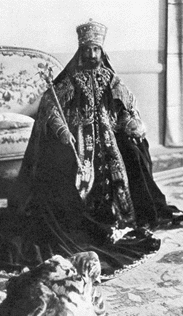 Emperor Haile Selassie I, Conquering Lion of Judah, Elect of God, King of Kings of Ethiopia in fullCoronation Regalia
Emperor Haile Selassie I, Conquering Lion of Judah, Elect of God, King of Kings of Ethiopia in fullCoronation Regalia
 OnNovember 1st, 1930, the new Emperor of Ethiopia paid his respects tohis illustrous predicesor, by erecting a equistrian statue of EmperorMenelik II infront of the Cathedral of St. George. Addis Ababa'sstreets had been newly repaved, electrical lights put up and unsightlyslums cleaned up for the spectical that would follow the next day. OnNovember 2nd, 1930, Haile Sellasie I was crowned Emperor of Ethiopia bythe Coptic Archbishop, Abune Kyrillos at the Cathedral of St. George.His wife was also crowned as Empress, and Crown Prince Asfaw Wossenanointed as Heir to the Throne. The coronation was the most splendidyet. The Emperor and Empress were driven to the Cathedral in an opencar as footmen riding behind them held red velvet umbrellas, heavilyembroidered in gold, over their heads on November 1st. After an allnight vigil at the Cathedral, the foreign guests arrived to witness theanointing and crowning of the Imperial couple and the anointing of thecrown prince. Around the outdoor dias were four large live lions,chained to the platform on which the Emperor sat with gold chains. TheEmperor and Empress were crowned outdoors infront of the Cathedral andenthroned there, as canons boomed a 100 gun salute, church bells rang,women ulultated and men cheered. The Imperial family, under a largeportable gold encrusted canopy of red velvet, the upper nobility andclergy along with the foreign delegations then entered the cathedral tohear mass. The coronation was witnessed by royalty and importantdignitaries from around the world. Representing the British Empire wasH.R.H. Prince Henry, Duke of Gloucester, son of King George V, brotherto Kings Edward VIII and George VI, and uncle to Queen Elizabeth II.Representing Italy was H.R.H. Prince Eugenio Di Savoia, Duke of Udine,cousin of the King of Italy. France was represented by Marshal FranchetD'Esperry. The King of Belgium was represented by Monseiur Gerard, theKing of Sweden by Baron Dabells, the Queen of the Netherlands by Mr.Unhar Hersmadd, the Emperor of Japan by Baron Ezbur, the King of Egyptby Tewfik Nessim Pasha, the Greek government by Count Metaxis, thegovernment of Turkey by Muhitin Pasha, the government of Poland byCount David Bazaki, the President of Germany by Baron Balthaussen, andthe President of the United States by Mr. Jacobi. The internationalpress was also present, a first for Ethiopian coronations. Followingthe church ceremonies, the Emperor and Empress boarded the formerImperial Coach of Germany, which had been purchased from the Germangovernment earlier. Thousands of Ethiopian subjects and nobles linedthe streets to the palace and witnessed the procession, the lastcoronation the country would see.
OnNovember 1st, 1930, the new Emperor of Ethiopia paid his respects tohis illustrous predicesor, by erecting a equistrian statue of EmperorMenelik II infront of the Cathedral of St. George. Addis Ababa'sstreets had been newly repaved, electrical lights put up and unsightlyslums cleaned up for the spectical that would follow the next day. OnNovember 2nd, 1930, Haile Sellasie I was crowned Emperor of Ethiopia bythe Coptic Archbishop, Abune Kyrillos at the Cathedral of St. George.His wife was also crowned as Empress, and Crown Prince Asfaw Wossenanointed as Heir to the Throne. The coronation was the most splendidyet. The Emperor and Empress were driven to the Cathedral in an opencar as footmen riding behind them held red velvet umbrellas, heavilyembroidered in gold, over their heads on November 1st. After an allnight vigil at the Cathedral, the foreign guests arrived to witness theanointing and crowning of the Imperial couple and the anointing of thecrown prince. Around the outdoor dias were four large live lions,chained to the platform on which the Emperor sat with gold chains. TheEmperor and Empress were crowned outdoors infront of the Cathedral andenthroned there, as canons boomed a 100 gun salute, church bells rang,women ulultated and men cheered. The Imperial family, under a largeportable gold encrusted canopy of red velvet, the upper nobility andclergy along with the foreign delegations then entered the cathedral tohear mass. The coronation was witnessed by royalty and importantdignitaries from around the world. Representing the British Empire wasH.R.H. Prince Henry, Duke of Gloucester, son of King George V, brotherto Kings Edward VIII and George VI, and uncle to Queen Elizabeth II.Representing Italy was H.R.H. Prince Eugenio Di Savoia, Duke of Udine,cousin of the King of Italy. France was represented by Marshal FranchetD'Esperry. The King of Belgium was represented by Monseiur Gerard, theKing of Sweden by Baron Dabells, the Queen of the Netherlands by Mr.Unhar Hersmadd, the Emperor of Japan by Baron Ezbur, the King of Egyptby Tewfik Nessim Pasha, the Greek government by Count Metaxis, thegovernment of Turkey by Muhitin Pasha, the government of Poland byCount David Bazaki, the President of Germany by Baron Balthaussen, andthe President of the United States by Mr. Jacobi. The internationalpress was also present, a first for Ethiopian coronations. Followingthe church ceremonies, the Emperor and Empress boarded the formerImperial Coach of Germany, which had been purchased from the Germangovernment earlier. Thousands of Ethiopian subjects and nobles linedthe streets to the palace and witnessed the procession, the lastcoronation the country would see.
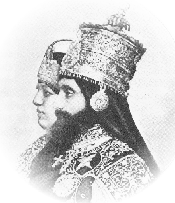 The Official Coronation Portrait of Their Imperial Majesties, Emperor Haile Selassie and Empress Menen of Ethiopia.
The Official Coronation Portrait of Their Imperial Majesties, Emperor Haile Selassie and Empress Menen of Ethiopia.
National Geographic took photographs of the Emperor in his coronationrobes and covered the events in their next issue. The pagents did notgo off without a glitch however. During welcoming ceremonies for theforeign delegations there was one significant event that caused minordisruption. As Crown Prince in 1923, the Emperor had visited Jerusalem.While there, the Armenian Patriarch and Catholicos of Jerusalem had methim, and told him of the plight of the large number of Armenian orphansbeing raised by the Patriarchate, and the financial dificulty this hadplaced on the patriarchate. These children were among the survivors ofthe huge massacres of Armenians by the Turks a few years earlier. Thethen Crown Prince had decided to help the Armenian Patriarch by takingsome of these orphans to Ethiopia to raise them in a country thatshared the Oriental Orthodox heritage of their dead parents. TheseArmenian youths had formed a marching band in Ethiopia that played atmany public events, and at the Palace as well for Imperial occasions ofstate. During the welcoming ceremonies before the coronation, theywould play the national anthem of which ever delegation was arriving atthe train station. When the Turkish delegation arrived, the Armenianyouths staunchly refused to play the Turkish anthem causing the Emperorto be very embarrassed and quite angry. The Emperor decided to put thematter before the senior princes and nobles in council to decide how topunish the Armenians for disobeying the monarch. When the councildemanded an explanation from the band, the Armenians tearfully repliedthat it was against their conscience to honor those who had butcheredtheir fathers and mothers. Much moved, the council agreed that it wastoo much to expect the Armenians to honor the representative of Turkey,so they recomended that they not be punished. The Emperor agreed andthe Armenians were allowed to disobey the Emperor and refuse to playthe Turkish National Anthem as it was in violation of the commandment"Honor your Father and Mother". Among the guests at the coronation wasthe novelist Evlyn Waugh who would one day be a major defender andapologist for the fascists and Mussolini's invasion and occupation ofEthiopia.
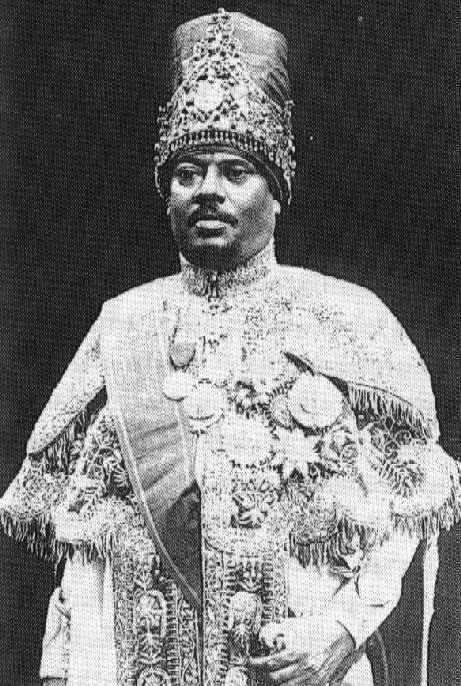 RasBirru Wolde Gabriel at the time of Emperor Haile Selassie'scoronoation. The Ras was often rumored to be the illegitimate son ofEmperor Menelik II
RasBirru Wolde Gabriel at the time of Emperor Haile Selassie'scoronoation. The Ras was often rumored to be the illegitimate son ofEmperor Menelik II
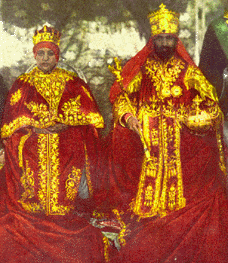 Emperor Haile Selassie I and Empress Menen of Ethiopia at their Coronation, November 2nd, 1930
Emperor Haile Selassie I and Empress Menen of Ethiopia at their Coronation, November 2nd, 1930
 Emperor Haile Selassie began an agressive programme of modernizationand centralization of the structure of the state. He ordered thedrafting of the first written constitution for the Empire, whichwas completed and promulgated in 1931. The First Imperial Constitution,which borrowed heavily from the Meiji Constitution of Japan, providedfor a Parliament for the first time in Ethiopian History. TheParliament was composed of two houses, a House of Deputies (lowerhouse) and an Imperial Senate (upper house). The Senate was comprisedof High Nobles, and important personages who were appointed to theirseats by the Emperor. The lower house was made up of land owners, andwas also filled by appointment of the Emperor. Although the structureof this new constitution maintained the absolute power of the monarhcy,it did set down the rights of the people. As was traditional, theSupreme Court of Ethiopia remained the Emperor's Chilot, where theEmperor heard the cases himself and passed down the final verdict.Every subject had the right to appeal to this court and to be heard.The ministries were staffed with men who shared the Emperorsprogressive views, and advisors were employed from abroad to help themin their work. The cabinet of ministers, established by Menelik II wasexpanded, and under the constitution it had an advisory role to themonarch, as well as running the day to day affairs of state. EmperorHaile Selassiebeing the type of person he was, however, was not one to let others dothe work of state. He was very active early in his reign with the mostminute details of government. However, as he grew older, andthe government grew in size and in function, he began to have less andless of a role, and simply excersized his final approval/veto ofpolicies formulated and excecuted by the increasing number oftechnocrats.The Emperor had no Prime Minister, but the Tsehafi Te-ezaz, atraditional title that had been converted into the Minister of the Penin the modern cabinet, was the most senior of the ministers. After1961, however,the Emperor decided to appoint a Prime Minister to take on more of thePolicy formulation role in government. Early in his reign though, therewere not enough educated Ethiopians to take on the responsibilitiesthis would entail. The Emperor also used the restructuring of thegovernment to severly curtail the powers of the aristocracy and theregional princely and noble families. The 1931 constitution limited thesuccession to the Imperial Throne not only to the House of Solomon, butwithin the House, to direct decendants of Emperor Haile Selassie. Thislimit on the Imperial succession caused considerable unhappiness amongthe Princes of the Imperial blood who were expected to sign away theirpotential claims to the throne by endorsing the constitution,particularly Ras Hailu of Gojjam and the princes of Tigrai, Ras Gugsaand Ras Seyoum. Ras Kassa Hailu himself, a firm ally of the Emperor inmost matters, and a man who had refused to be considered for the thronehimself, was not the least bit pleased that his decendents should beexcluded in this manner. He pled illness and was not present for thesigning of the constitution, and did not sign it. The Emperorencouraged the spread of modern education, and sponsored many youngEthiopians to go to Europe to study. He built the Haile Selassie IHospital (known today as the Yekatit 22), and several schools. A modernmilitary was being developed with the aid of European advisors. TheSwedes trained his Imperial Guard, and the Belgians his Imperial Army.He recieved the Crown Prince of Sweden Gustav Adolph and his wife for astate visit and housed them in the newly built Guenete Leul Palace,built on the site of his fathers old house. After the visit, theEmperor and Empress moved in to the new palace themselves, and itbecame known as the Little Guibi (the Menelik or Imperial Palace beingthe Great Guibi). Ethiopia sought to emulate Japan in it's developmentstrategies, something that the colonial powers in the region were notvery pleased about.
Emperor Haile Selassie began an agressive programme of modernizationand centralization of the structure of the state. He ordered thedrafting of the first written constitution for the Empire, whichwas completed and promulgated in 1931. The First Imperial Constitution,which borrowed heavily from the Meiji Constitution of Japan, providedfor a Parliament for the first time in Ethiopian History. TheParliament was composed of two houses, a House of Deputies (lowerhouse) and an Imperial Senate (upper house). The Senate was comprisedof High Nobles, and important personages who were appointed to theirseats by the Emperor. The lower house was made up of land owners, andwas also filled by appointment of the Emperor. Although the structureof this new constitution maintained the absolute power of the monarhcy,it did set down the rights of the people. As was traditional, theSupreme Court of Ethiopia remained the Emperor's Chilot, where theEmperor heard the cases himself and passed down the final verdict.Every subject had the right to appeal to this court and to be heard.The ministries were staffed with men who shared the Emperorsprogressive views, and advisors were employed from abroad to help themin their work. The cabinet of ministers, established by Menelik II wasexpanded, and under the constitution it had an advisory role to themonarch, as well as running the day to day affairs of state. EmperorHaile Selassiebeing the type of person he was, however, was not one to let others dothe work of state. He was very active early in his reign with the mostminute details of government. However, as he grew older, andthe government grew in size and in function, he began to have less andless of a role, and simply excersized his final approval/veto ofpolicies formulated and excecuted by the increasing number oftechnocrats.The Emperor had no Prime Minister, but the Tsehafi Te-ezaz, atraditional title that had been converted into the Minister of the Penin the modern cabinet, was the most senior of the ministers. After1961, however,the Emperor decided to appoint a Prime Minister to take on more of thePolicy formulation role in government. Early in his reign though, therewere not enough educated Ethiopians to take on the responsibilitiesthis would entail. The Emperor also used the restructuring of thegovernment to severly curtail the powers of the aristocracy and theregional princely and noble families. The 1931 constitution limited thesuccession to the Imperial Throne not only to the House of Solomon, butwithin the House, to direct decendants of Emperor Haile Selassie. Thislimit on the Imperial succession caused considerable unhappiness amongthe Princes of the Imperial blood who were expected to sign away theirpotential claims to the throne by endorsing the constitution,particularly Ras Hailu of Gojjam and the princes of Tigrai, Ras Gugsaand Ras Seyoum. Ras Kassa Hailu himself, a firm ally of the Emperor inmost matters, and a man who had refused to be considered for the thronehimself, was not the least bit pleased that his decendents should beexcluded in this manner. He pled illness and was not present for thesigning of the constitution, and did not sign it. The Emperorencouraged the spread of modern education, and sponsored many youngEthiopians to go to Europe to study. He built the Haile Selassie IHospital (known today as the Yekatit 22), and several schools. A modernmilitary was being developed with the aid of European advisors. TheSwedes trained his Imperial Guard, and the Belgians his Imperial Army.He recieved the Crown Prince of Sweden Gustav Adolph and his wife for astate visit and housed them in the newly built Guenete Leul Palace,built on the site of his fathers old house. After the visit, theEmperor and Empress moved in to the new palace themselves, and itbecame known as the Little Guibi (the Menelik or Imperial Palace beingthe Great Guibi). Ethiopia sought to emulate Japan in it's developmentstrategies, something that the colonial powers in the region were notvery pleased about.

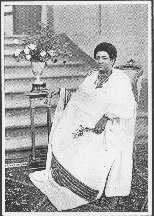 Empress Menen (possibly shortly before the birth of H.I.H. Prince Sahle Selassie)
Empress Menen (possibly shortly before the birth of H.I.H. Prince Sahle Selassie)

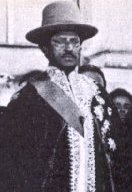 Ras Hailu Tekle Haimanot, Prince of GojjamItwas during this time, late 1931, that Lij Eyasu escaped from hisdetention at Selale. He was hunted down and captured, andre-imprisoned, this time in much less comfortable circumstances at GaraMuleta in Harar. Eyasuism wouldcontinue to be a thorn in the side of the government. Lij Eyasu himselfwould remain a prisoner, but among the people of Wollo and amongvarious elements in the nobility, there were strong feelings that hewas the true and legitimate heir to Menelik II, and this belief wouldpersist for a long time. Upon the recapture of Lij Eyasu, it was foundthat he had been aided by his former father-in-law, the Prince ofGojjam, Leul Ras Hailu Tekle Haimanot, in concert with the Italiancolonial authorities in Eritrea. The Gojjami prince, who previously hadbeen convicted of conspiracy to murder someone, was now sentenced tolife imprisonment. Behind his plot to restore his ex-son-in-law wasHailu's deep resentment at not having been made King of Gojjam insuccession to his late father, Tekle Haimanot. Ras Hailu was afabulously wealthy man, he may have well been the richest man in theEmpire. He taxed Gojjam brutally, and he owned lavish homes both at hisseat in Gojjam at Debre Markos, and in the capital. His relations withhis his brothers, Ras Bezabeh, and Dejazmatch Bellew were not warm, andall three brothers at various times had quarelled with their father andsought the protection of Menelik. Menelik II always partial to the Kingof Gojjam, never tried to undermine him by using his sons against him,but rather counseled the sons to honor their father. Tekle Haimanot wasaware of this, and appreciated it. Upon Tekle Haimanot's death, hiswidow Laquech Gebre Medhin, sister of Emperor Tekle Giorgis III, wantedto rule Gojjam as successor to her husband as did both Bezabih andBellew who were at court with Menelik. Her argument was that herstepsons had behaved badly toward their father and so she should beconsidered his heir. Bezabih had married Lij Eyasu's sister Zenebework,but it was Seyoum ( who changed his name to Hailu) who ended up withthe bulk of Gojjam. Now though, Emperor Haile Selassie was determinednot to create anymore vassal kings within the Empire followingMenelik's example. Menelik had chosen to recognize Tekle Haimanot asking of Gojjam because that title had been granted by Yohannis IV, buthe didn't create anyKings elsewhere as he could have. Lij Eyasu had created his father Kingof Wollo, and Zewditu had made her cousin Wolde Giorgis King of Gondar,but the new Emperor was having none of that. The Tigrean and Gojjamiroyals were created "Leul" or Prince, their wives granted the title of"Lielt" or Princess. Thus Rases Seyoum Mengesha and Gugsa Araya(succeeded by Dejazmatch Haile Selassie Gugsa) in Tigrai, Hailu,Bezabih, and Bellew (succeeded by Hailu Bellew) in Gojjam, and KassaHailu, and Imiru Haile Selassie in Shewa, made up a tier of "Princes ofthe Blood". They were royals with Solomonic blood who surrounded thethrone of Haile Selassie, but knew that they could never hope to bemade kings in his reign. Ras Hailu was resentful, and his aid to LijEyasu was probably in reaction to this. With his imprisonment though,The Emperor replaced him with Ras Imiru, his own cousin, and sentrepresentatives of the central government to take over Hailu's propertyand the entire province of Gojjam bringing under the direct rule of thecentral government and ending the reign of the Gojjambranch of the dynasty in the province. His nephew, Ras Hailu Bellewwould briefly govern Gojjam in the 1950's.
Ras Hailu Tekle Haimanot, Prince of GojjamItwas during this time, late 1931, that Lij Eyasu escaped from hisdetention at Selale. He was hunted down and captured, andre-imprisoned, this time in much less comfortable circumstances at GaraMuleta in Harar. Eyasuism wouldcontinue to be a thorn in the side of the government. Lij Eyasu himselfwould remain a prisoner, but among the people of Wollo and amongvarious elements in the nobility, there were strong feelings that hewas the true and legitimate heir to Menelik II, and this belief wouldpersist for a long time. Upon the recapture of Lij Eyasu, it was foundthat he had been aided by his former father-in-law, the Prince ofGojjam, Leul Ras Hailu Tekle Haimanot, in concert with the Italiancolonial authorities in Eritrea. The Gojjami prince, who previously hadbeen convicted of conspiracy to murder someone, was now sentenced tolife imprisonment. Behind his plot to restore his ex-son-in-law wasHailu's deep resentment at not having been made King of Gojjam insuccession to his late father, Tekle Haimanot. Ras Hailu was afabulously wealthy man, he may have well been the richest man in theEmpire. He taxed Gojjam brutally, and he owned lavish homes both at hisseat in Gojjam at Debre Markos, and in the capital. His relations withhis his brothers, Ras Bezabeh, and Dejazmatch Bellew were not warm, andall three brothers at various times had quarelled with their father andsought the protection of Menelik. Menelik II always partial to the Kingof Gojjam, never tried to undermine him by using his sons against him,but rather counseled the sons to honor their father. Tekle Haimanot wasaware of this, and appreciated it. Upon Tekle Haimanot's death, hiswidow Laquech Gebre Medhin, sister of Emperor Tekle Giorgis III, wantedto rule Gojjam as successor to her husband as did both Bezabih andBellew who were at court with Menelik. Her argument was that herstepsons had behaved badly toward their father and so she should beconsidered his heir. Bezabih had married Lij Eyasu's sister Zenebework,but it was Seyoum ( who changed his name to Hailu) who ended up withthe bulk of Gojjam. Now though, Emperor Haile Selassie was determinednot to create anymore vassal kings within the Empire followingMenelik's example. Menelik had chosen to recognize Tekle Haimanot asking of Gojjam because that title had been granted by Yohannis IV, buthe didn't create anyKings elsewhere as he could have. Lij Eyasu had created his father Kingof Wollo, and Zewditu had made her cousin Wolde Giorgis King of Gondar,but the new Emperor was having none of that. The Tigrean and Gojjamiroyals were created "Leul" or Prince, their wives granted the title of"Lielt" or Princess. Thus Rases Seyoum Mengesha and Gugsa Araya(succeeded by Dejazmatch Haile Selassie Gugsa) in Tigrai, Hailu,Bezabih, and Bellew (succeeded by Hailu Bellew) in Gojjam, and KassaHailu, and Imiru Haile Selassie in Shewa, made up a tier of "Princes ofthe Blood". They were royals with Solomonic blood who surrounded thethrone of Haile Selassie, but knew that they could never hope to bemade kings in his reign. Ras Hailu was resentful, and his aid to LijEyasu was probably in reaction to this. With his imprisonment though,The Emperor replaced him with Ras Imiru, his own cousin, and sentrepresentatives of the central government to take over Hailu's propertyand the entire province of Gojjam bringing under the direct rule of thecentral government and ending the reign of the Gojjambranch of the dynasty in the province. His nephew, Ras Hailu Bellewwould briefly govern Gojjam in the 1950's.
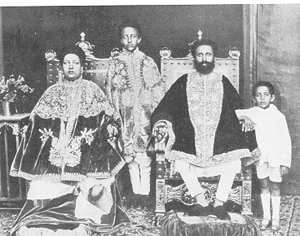 From Left to Right, Her Imperial Majesty Empress Menen,His Imperial HignessCrown Prince Asfaw Wossen, His Imperial Majesty Emperor Haile Selassie, His Imperial HighnessPrince Makonnen Duke of Harrar, 1931
From Left to Right, Her Imperial Majesty Empress Menen,His Imperial HignessCrown Prince Asfaw Wossen, His Imperial Majesty Emperor Haile Selassie, His Imperial HighnessPrince Makonnen Duke of Harrar, 1931
 The Emperor continued with his modernizing zeal. Foriegn advisors wereappointed to assist in advising and helping to set up a modernadministration and beurocracy in the various ministries. The cadre ofyoung educated people known as the "Young Ethiopians" made up a newdomestic intelegencia which was rooted in progressive and modernistphilosopy, and were relied on by the Emperor to carry out his plans forthe Empire. They were eager and willing to work hard towards this goal.The Emperor continued to promote men of humble background to positionsof the highest responsibility at the expence of the traditionalnobility. The commoners, he believed, would be more directly loyal tohim because they would owe him their education and high stationcompletely, and be more likely to act in his interests. The oldnobility was too conservative, and too ambitious with their own familyinterests and personal ambitions to promote. The aristocracy wasincreasingly resentful of the commoners that the Emperor seemed tofavor, and they campaigned for him to return to appointing people fromthe noble classes to powerful posts. The Emperor decided to balance onegroup against the other by creating the Crown Council. The Cabinet ofMinisters would eventually be dominated by commoners with a few nobleshere and there, while the Crown Council would be dominated by theAristocracy with a few commoners included. It was into this situationthat the country would spiral into the Ethio-Italian conflict of 1936,and the prelude to World War II.
The Emperor continued with his modernizing zeal. Foriegn advisors wereappointed to assist in advising and helping to set up a modernadministration and beurocracy in the various ministries. The cadre ofyoung educated people known as the "Young Ethiopians" made up a newdomestic intelegencia which was rooted in progressive and modernistphilosopy, and were relied on by the Emperor to carry out his plans forthe Empire. They were eager and willing to work hard towards this goal.The Emperor continued to promote men of humble background to positionsof the highest responsibility at the expence of the traditionalnobility. The commoners, he believed, would be more directly loyal tohim because they would owe him their education and high stationcompletely, and be more likely to act in his interests. The oldnobility was too conservative, and too ambitious with their own familyinterests and personal ambitions to promote. The aristocracy wasincreasingly resentful of the commoners that the Emperor seemed tofavor, and they campaigned for him to return to appointing people fromthe noble classes to powerful posts. The Emperor decided to balance onegroup against the other by creating the Crown Council. The Cabinet ofMinisters would eventually be dominated by commoners with a few nobleshere and there, while the Crown Council would be dominated by theAristocracy with a few commoners included. It was into this situationthat the country would spiral into the Ethio-Italian conflict of 1936,and the prelude to World War II. 
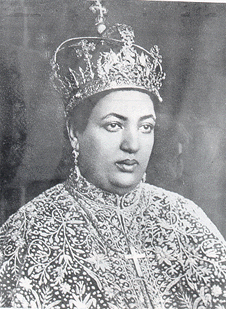 Her Imperial Majesty Empress Menen, 1930
Her Imperial Majesty Empress Menen, 1930
 Her Imperial Majesty Empress Menen was born in Wollo in 1889. She wasthe daughter of Jantirar Asfaw of Ambassel, and his wife, Woizero SehinMichael. Woizero Sehin was the daughter of King Michael of Wollo andhalf sister of Lij Eyasu. Through King Michael, Empress Menen couldtrace her ancestry back to Emperor Fasiledes and also to the ProphetMohammed. Empress Menen had been married three times prior to hermarriage to Emperor Haile Selassie. Her husband immediately before theEmperor had been Ras Leulseged Atnafseged. From her first husbandEmpress Menen had two children, Woizero Belainesh Ali, and JantirarAsfaw Ali. From her second marriage, she had two more children,Jantirar Gebre Igziabiher Amede and Woizero Desta Amede. She had nochildren from her brief marriage to Ras Leulseged. The Empress thus hadten children altogether and the Emperor therefore had 4 step-children.Empress Menen married Emperor Haile Selassie on July 30th 1910, whilehe was still Dejazmatch Taffari Makonnen of Harrar. Unlike her previousmarriages, this one was a church wedding with a communion service, thusthe only one of her marriages recognized by the Orthodox Church. Themarriage is said to have been promoted by the Lord Regent, Ras TessemaNadew and Fitawrari Hapte Giorgis Denagde in order to tie DejazmatchTaffari more closely to Lij Eyasu and ensure his loyalty. Some say LijEyasu ordered his paternal niece to marry his maternal cousin, whileothers say he actively promoted the match after the couple first met athis home in Addis Ababa and were smitten, and he realized the politicaladvantages to him. Whatever one believes, what is certain is that theirmarriage proved very successful and long lasting. The Emperor andEmpress celebrated their golden wedding aniversary in 1960. HerImperial Majesty died in 1961 after 51 years of marriage, at the age of71. She had been Empress of Ethiopia for 32 years at the time of herdeath. She was buried at Holy Trinity Cathedral in Addis Ababa.History of Emperor Haile Selassie Continued in Part 2
Her Imperial Majesty Empress Menen was born in Wollo in 1889. She wasthe daughter of Jantirar Asfaw of Ambassel, and his wife, Woizero SehinMichael. Woizero Sehin was the daughter of King Michael of Wollo andhalf sister of Lij Eyasu. Through King Michael, Empress Menen couldtrace her ancestry back to Emperor Fasiledes and also to the ProphetMohammed. Empress Menen had been married three times prior to hermarriage to Emperor Haile Selassie. Her husband immediately before theEmperor had been Ras Leulseged Atnafseged. From her first husbandEmpress Menen had two children, Woizero Belainesh Ali, and JantirarAsfaw Ali. From her second marriage, she had two more children,Jantirar Gebre Igziabiher Amede and Woizero Desta Amede. She had nochildren from her brief marriage to Ras Leulseged. The Empress thus hadten children altogether and the Emperor therefore had 4 step-children.Empress Menen married Emperor Haile Selassie on July 30th 1910, whilehe was still Dejazmatch Taffari Makonnen of Harrar. Unlike her previousmarriages, this one was a church wedding with a communion service, thusthe only one of her marriages recognized by the Orthodox Church. Themarriage is said to have been promoted by the Lord Regent, Ras TessemaNadew and Fitawrari Hapte Giorgis Denagde in order to tie DejazmatchTaffari more closely to Lij Eyasu and ensure his loyalty. Some say LijEyasu ordered his paternal niece to marry his maternal cousin, whileothers say he actively promoted the match after the couple first met athis home in Addis Ababa and were smitten, and he realized the politicaladvantages to him. Whatever one believes, what is certain is that theirmarriage proved very successful and long lasting. The Emperor andEmpress celebrated their golden wedding aniversary in 1960. HerImperial Majesty died in 1961 after 51 years of marriage, at the age of71. She had been Empress of Ethiopia for 32 years at the time of herdeath. She was buried at Holy Trinity Cathedral in Addis Ababa.History of Emperor Haile Selassie Continued in Part 2
Click Here to Continue with Part II of History and PicturesBack to Imperial Ethiopia Homepage
Email: ethiocrown@angelfire.com


